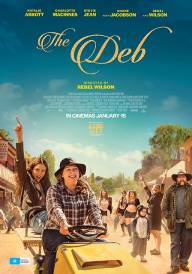Will Arnett The Lego Batman Movie

Will Arnett The Lego Batman Movie
Cast: Will Arnett, Rosario Dawson, Zach Galifianakis, Ralph Fiennes, Jenny Slate, Michael Cera, Mariah Carey
Director: Chris McKay
Genre: Action, Animation
Rated: PG
Running Time: 104 minutes
Synopsis: In the irreverent spirit of fun that made 'The LEGO® Movie" a worldwide phenomenon, the self-described leading man of that ensemble LEGO® Batman stars in his own big-screen adventure.
But there are big changes brewing in Gotham City, and if he wants to save the city from The Joker's hostile takeover, Batman may have to drop the lone vigilante thing, try to work with others and maybe, just maybe, learn to lighten up.
The Lego Batman Movie
Release Date: March 30th, 2017
About The Production
Back In Black…And Yellow
Bringing together the energy, imagination and memorable characters from both the LEGO world DC universe, 'The LEGO Batman Movie" welcomes audiences of all ages into a world of DC Super Heroes and Super-Villains uniquely realized for the big screen. With plenty of action, fun, and laughs, plus Batman's amazing arsenal of gadgets and vehicles and the Batcave as it's never been built before"brick by LEGO brick"this brand-new adventure also asks the question, can Batman just get over himself and be happy?
The film's star is LEGO Batman, the coolest, handsomest, buff-est, and most awesome leading man of all time….even if he does say so himself.
And he does. Frequently.
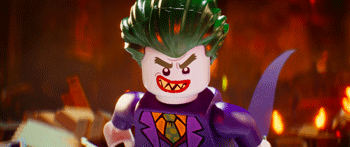 'The -LEGO Movie' version of Batman was such a favorite, breakout character, and I'm sure he would agree that he deserves to be the focus of his own movie and not some third banana. He feels he's definitely a first-banana kind of guy," says Christopher Miller, who, along with Phil Lord, wrote and directed 'The LEGO Movie" in 2014. Keeping the creative collaboration both fresh and familiar, the duo returns as producers on 'The LEGO Batman Movie," directed by Chris McKay, their filmmaking partner who served as animation director and editor on the first film.
'The -LEGO Movie' version of Batman was such a favorite, breakout character, and I'm sure he would agree that he deserves to be the focus of his own movie and not some third banana. He feels he's definitely a first-banana kind of guy," says Christopher Miller, who, along with Phil Lord, wrote and directed 'The LEGO Movie" in 2014. Keeping the creative collaboration both fresh and familiar, the duo returns as producers on 'The LEGO Batman Movie," directed by Chris McKay, their filmmaking partner who served as animation director and editor on the first film.
Joining Batman this time is the super-positive and freakishly agile young Dick Grayson, on his way to becoming Robin; Batman's loyal and deceptively reserved butler, Alfred; Gotham City's new police commissioner Barbara Gordon, aka Batgirl, who wields major girl power; and The Joker, who desperately wants the recognition he deserves"in a story that not only showcases Batman's sick skills and enviable abs but also takes a searching look into his personality. Specifically, this lone wolf's need to work alone, to brood alone on his dark past and generally distance himself from everyone to a degree that is starting to make him seem, well, a little bit dysfunctional.
'Batman is beloved the world over and for good reason, yet no one could really behave the way he does and get away with it, which is what we're exploring in the movie," says lifelong fan Chris McKay, who nevertheless feels that even at the character's most extreme, 'he's still very sympathetic."
'What was so special about Batman in the first movie is that he was selfish and egotistical, but still loveable in his own way," is the assessment of returning producer Dan Lin.
'He had no self-awareness and it was a new twist on the character, someone who often said the most outrageous things. It's a subversion of the Super Hero genre, but with a joyous heart and told in a family-friendly LEGO way."
Adds McKay, 'When we were figuring out what kind of movie this would be, we knew that he could be funny and charming, we knew there were plenty of opportunities for jokes, but we wanted it to be more than all gags and sketch comedy. It had to be an absurd, action movie. But it also had to be moving, with an emotional core to these characters and a reason for people to get involved. We wanted to have it all: to respect them as individuals with all their complexities and defining traits while at the same time looking at those traits in the funniest possible way."
The best example of this is Batman's perpetual state of somber introspection, never mind the fact that, as Lord points out, 'He's got a great life. He's a billionaire, he's handsome, he's strong, he has great cars and gadgets, and he gets to punch people in the face with no repercussions! I mean, the guy should be grinning from ear to ear all the time. So we thought the tension between how he feels and how he should feel was a great premise and something we wanted to poke fun at."
The writers on 'The LEGO Batman Movie" have roots in a range of comedic and/or animated projects. Seth Grahame-Smith's novel Pride and Prejudice and Zombies was made into a successful feature; writing partners Chris McKenna and Erik Sommers have been recognised for their work on 'Community" and 'American Dad"; Jared Stern counts 'Toy Story 3" and 'Wreck-It Ralph" among his feature animation credits; and John Whittington is a staff writer on the upcoming series 'Green Eggs and Ham," based on the classic Dr. Seuss children's book.
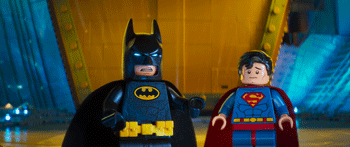 Reprising his role as the gravelly voiced DC Super Hero with issues is Will Arnett, who concurs, 'It's fun to take an iconic figure like Batman and play with the rules that have always been in place for him, to keep it consistent in terms of his being good at what he does and having that bravado and machismo, but play up his flaws and make him a little goofier without entirely losing his cool. That's the kind of license we took originally, and then expanded on that to really get down to what makes Batman tick."
Reprising his role as the gravelly voiced DC Super Hero with issues is Will Arnett, who concurs, 'It's fun to take an iconic figure like Batman and play with the rules that have always been in place for him, to keep it consistent in terms of his being good at what he does and having that bravado and machismo, but play up his flaws and make him a little goofier without entirely losing his cool. That's the kind of license we took originally, and then expanded on that to really get down to what makes Batman tick."
Speaking of ticking… The story opens with a spectacular action sequence as The Joker, voiced by Zach Galifianakis, gleefully leads the vast Rogues Gallery of baddies in a series of heists culminating in a full-scale attack on Gotham City, with a time bomb that Batman must quickly locate and defuse. But it's not just mayhem The Joker craves now. After decades of unresolved conflict, point and counterpoint, the Clown Prince of Crime justifiably feels that he and the Caped Crusader have forged a special hero/villain bond that needs to be formally acknowledged.
Naturally, Batman refuses, even if the fate of the city rests on his uttering those three magic words The Joker wants to hear: that he is, in fact, Batman's greatest enemy.
The filmmakers know, however, that putting Batman on the hot seat over his relationship with The Joker isn't enough by itself to prompt real soul-searching. So the story also introduces Dick Grayson, who comes to live under Batman's guardianship through a series of events The Dark Knight can't quite figure out. Voiced by Michael Cera, this talkative and enthusiastic youngster, destined to become Robin, brings a ray of sunshine into Batman's life but, along with it, a level of personal accountability he's not ready to assume.
Simultaneously, Batman is smitten by Gotham City's fearless and capable new police commissioner Barbara Gordon, played by Rosario Dawson, as a law enforcement pro with her own ideas about crime-fighting, and who could be a powerful ally if Batman would only accept her help. And, as if that's not enough, Batman's long-standing association with his butler and father figure Alfred comes to a crisis as Alfred, played by Ralph Fiennes, embarks on a toughlove campaign to force Batman out of the shadows and toward a healthier, happier lifestyle.
It's a lot of upheaval for a guy who just wants to save the city on a regular basis, soak in some public adulation and then hole up at home with his old photos and chick flicks. Or alternately, vent his deep angst writing heavy-metal rap.
While these storylines serve up a lot of laughs they also encourage Batman to recognise the value of teamwork versus going it alone, which is one of the film's central themes. Similarly, Batman's coming to terms with the significant people in his life touches upon another of the film's themes, which is the rewards of family, however a person comes to define that.
'The LEGO Batman Movie" again employs the digital animation technique that made 'The LEGO Movie" look and feel so tactile and engaging. Each scene and asset was built brick by brick, through a meticulous process of rendering and surfacing thousands of individual pieces and then assembling these as sets and props in the computer"much as people around the world do so to tell their own stories with LEGO play materials. Though entirely CG, it suggests the same stop-motion quality that gave its predecessor its distinctive handmade and hand-held look.
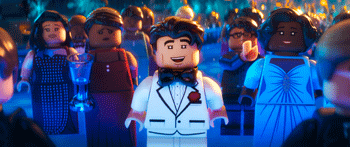 However, McKay notes, while the two films share a continuity of style, there are subtleties that set them apart: 'The look of this movie is different than -The LEGO Movie.' It's still within the same world but is more cinematic and photo real. The scale is larger, with wider camera lenses, and the characters are more detailed. Batman, for example, has a molded utility belt that he didn't have in the first film. We also incorporated some natural effects, like smoke and water."
However, McKay notes, while the two films share a continuity of style, there are subtleties that set them apart: 'The look of this movie is different than -The LEGO Movie.' It's still within the same world but is more cinematic and photo real. The scale is larger, with wider camera lenses, and the characters are more detailed. Batman, for example, has a molded utility belt that he didn't have in the first film. We also incorporated some natural effects, like smoke and water."
Because of the commitment to appropriately depict Batman's classic environs, unlike the sunny brights of the first film, McKay sought to balance the thematic darkness of such places as Gotham City, Wayne Manor and the Batcave with super-saturated color.
Overall, he says, 'We strove to make sure everything was up to the quality and standards set by -The LEGO Movie.'"
The creative team again honored the LEGO brand's imprint by finding ways to work with its physical properties authentically rather than 'cheating" movement. Thus, the Minifigures only move, turn and bend the way their real-life counterparts can. Referencing the director's extensive experience with stop-motion animation, Miller says, 'Chris is a genius at figuring out the tricks and challenges, how characters can move and how you can make them do things like clap or hug or scratch their foreheads, when their arms only go so far."
'What's compelling about the look of these LEGO movies is that it's your toys come to life," says Lin. 'And not only your toys but your imagination. If you could have all these LEGO bricks and build these amazing sets and vehicles, this is what it could look like."
Production ran concurrently in the U.S. and at the Sydney, Australia headquarters of award-winning digital design, animation and effects company Animal Logic, which provided the animation for 'The LEGO Movie"" reuniting many of the artists who worked on that film, again with input from the LEGO design team based in Billund, Denmark. For two and a half years, approximately 400 dedicated people collaborated to turn this beloved character onto his ear in a way that will delight adults as well as children.
'The LEGO Batman Movie" unapologetically deviates from the DC canon to a ridiculous degree…but, the filmmakers attest, with purpose as well as total love and respect. 'We all know, for example, that this is an inaccurate back-story for Barbara Gordon," Lord acknowledges. 'It literally has nothing to do with the canon whatsoever, but everyone knows this is a tongue-in-cheek version and it's all in good fun. It gave us an opportunity to present Batgirl as a strong female role model with a contemporary point of view."
'It doesn't count as real canon because these are little plastic people," adds Miller, with a laugh. 'And everything is done with affection for these characters. Chris McKay was a big factor in why the first LEGO movie was so successful; his tone and his point of view are all over it. He's a real genius. He's also a crazy, super-fan of Batman and DC comics and their history, so the guy's credentials are legit. He even has a tattoo of Catwoman on his forearm." It's true. He does, and will readily roll up his shirtsleeve to prove it.
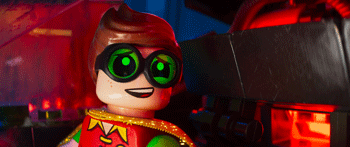 'These are our Greek gods and our archetypes," McKay explains. 'So it's irresistible sometimes to make fun of them, but also to find out what's true and real about them and what they represent, and what they mean to us. There are jokes here for people who want to delve deep and stuff that's just going to be silly and slapstick. The live-action films have a very different take on Batman, and I think what we're doing doesn't take anything away from that. We're still playing in the world they created."
'These are our Greek gods and our archetypes," McKay explains. 'So it's irresistible sometimes to make fun of them, but also to find out what's true and real about them and what they represent, and what they mean to us. There are jokes here for people who want to delve deep and stuff that's just going to be silly and slapstick. The live-action films have a very different take on Batman, and I think what we're doing doesn't take anything away from that. We're still playing in the world they created."
Despite the film's short-legged, claw-handed protagonists measuring one-and-a-half inches high, with printed facial features, 'The LEGO Batman Movie" was conceived, designed, lit, shot and scored like an epic action film. Therein, the filmmakers feel, lies its appeal as well as the crux of its humor and heart. Says McKay, 'There's something inherently funny about these little Minifigures taking things so seriously and having the action choreography unfold like some high-powered epic, with people rushing around trying to stop someone from detonating a bomb and all this crazy stuff.
'It's fun to stage massive action on this level," he adds, 'because it's all rendered in LEGO bricks so you still have the charm of something that is intimate and handmade."
Cast And Characters: The Battle For Gotham City
'Batman works alone. That's my motto. Copyright Batman." - Batman
For LEGO Batman, defending Gotham City from takeover plots by its thriving criminal underworld is an ongoing exercise. Time and again, this DC Super Hero and Master Builder swoops in to save the day, free the hostages, disarm the bombs and put the kibosh on whatever diabolical assault the city's enemies have most recently launched. Time and again, he is feted by police and politicians, gushed over by the media and cheered by a grateful public amidst parades and fireworks. The citizens love him. And he loves that they love him. Then he goes home alone as Bruce Wayne.
It's this self-imposed solitude that has always been part of the Batman legend and mystique, which McKay and his team have chosen to focus on in the extreme, with an aim toward making it both touching and hilarious. 'We're taking the subtext of the character and putting that on the surface," says McKay. 'Batman is so dark and brooding, so our premise was to explore that, like, -What's this guy's problem?' Can he actually be happy? Can he still function as a Super Hero but also learn to enjoy himself and learn to work with other people? Let's force him into a situation where he has to confront these issues and see how he does." Will Arnett says, 'I love this character because he has a lot of depth and mystery.
Everything he does comes from an emotional place. Plus, he's not a guy who was born with a super power; he was someone who faced tough times and was forced to use his head to get on top of each situation and I thought that was pretty cool. He's Batman, but he's not perfect. And I think people will understand that and find it funny and human."
One of the hallmarks of Arnett's characterization is the low-octave vocal, a cross between a growl and a hoarse whisper that's shared by both Batman and his true identity, Bruce Wayne. He relates how he originated the unique rasp on the first film in sessions with Phil Lord and Christopher Miller. 'We played with the various levels before we found that sweet spot. We wanted it to have a kind of deep resonance and be super-serious because this is a guy who takes himself very seriously."
It was an artistic decision for which Arnett has suffered ever since. 'I kind of run out of steam after three or four hours, and then I can't talk for a month," he says jokingly.
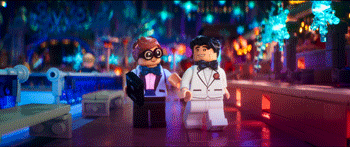 But, Lord affirms, totally worth the effort. 'The guy makes me laugh just from the sound of his voice." Additionally, says Miller, 'What's great about Will is that he plays Batman like a really arrogant guy, but there's all this vulnerability deep underneath that shines through in his voice and his delivery."
But, Lord affirms, totally worth the effort. 'The guy makes me laugh just from the sound of his voice." Additionally, says Miller, 'What's great about Will is that he plays Batman like a really arrogant guy, but there's all this vulnerability deep underneath that shines through in his voice and his delivery."
'His ability to give you something you weren't expecting that really drills down into the character, is amazing," McKay sums up. 'He's so inventive and charismatic, and game to try anything, and I think his attitude is 100 percent why the LEGO Batman character works."
In the story, Batman's unwillingness to connect with people on a meaningful level is exemplified by his rocky but longstanding relationship with Gotham City's premiere baddie, The Joker. Together, The Joker contends, with his typically skewed but not entirely off-point logic, they are a symbiotic pair: the yin and yang of peacekeeping in the city, each of their careers essentially pointless without the other. But this only prompts The Dark Knight to snarl, 'You're nothing to me. I don't need you. I don't need anyone."
Meant as a boast, it also reveals Batman's true loneliness.
'Do you realize you've never once said the words -I hate you, Joker.'" – The Joker
Clearly, The Joker has his own problems. One of the most recognised DC SuperVillains of all time, with his one-of-a-kind leering visage, The Joker lives entirely on his own terms. Feared and famous, he might be thrilled with his life if it were not for one thing: Batman. Apart from the obvious, that Batman has thwarted The Joker's attempts to take over Gotham City for, like, a thousand times in a row, there's the larger issue of respect. After all these years of knocking himself out trying to prove how dangerous and crazy he is, how formidable a foe, The Joker just wants a little validation. Is that too much to ask?
Says McKay, 'In our version The Joker is like Batman's black-sheep brother. He sees himself on the same level as Batman, opposites but equally matched. In his mind, they exist to make each other better. I think The Joker wants Batman to appreciate him for what he brings to the equation, to acknowledge his efforts and his ideas and their special relationship. But Batman always denies him."
It's a dance that has gone on for more than 70 years. 'At a certain point, you want to say, -Get a room, already,'" quips Arnett. 'The Joker is only a bad guy as long as Batman exists to fight against, and Batman allows him to exist because it gives him something to do. But what would happen if they both took a step back and understood that situation?"
To imbue their Joker with a volatile mix of edge and vulnerability, the filmmakers cast Zach Galifianakis, of whom Lord says, 'He's the kind of comedian who can be a little scary. He's good at creating tension around his comedy. If you watch him doing interviews on -Between Two Ferns,' you're worried that something bad might happen to him or to one of his guests."
Longtime friends Arnett and Galifianakis proved to have great chemistry and brought their natural rapport to the material"some of which they were able to record together.
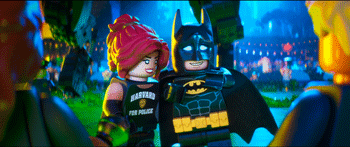 'The Joker is a great villain because he's unpredictable and wild and clever," says Galifianakis, who cites Jack Nicholson's late--80s characterization as one of his inspirations. 'But from his point of view, it's all about jealousy. He sees everything through that haze."
'The Joker is a great villain because he's unpredictable and wild and clever," says Galifianakis, who cites Jack Nicholson's late--80s characterization as one of his inspirations. 'But from his point of view, it's all about jealousy. He sees everything through that haze."
Further addressing the set-up, he says, 'Men don't talk about their friendships. So to force this almost therapeutic dialogue between the two of them just seemed natural and a fun thing to play on, as if they were working out their problems. It's a subverted take on Batman where he deals with some real-life issues and complaints. Because it's animated, we're allowed to play with those personalities that are so private and guarded, and you'll see Batman and The Joker being whiny or needy in a way you'd never see in a live-action film. And that, to me, is what's so funny about it."
'I have two dads and one of them is Batman!" – Dick Grayson / Robin
Even as Batman is being pressured by The Joker to concede the special nature of their relationship"a word that positively makes him blanch" he finds himself in the completely alien position of having to care for"and care about"a young man to whom he has unwittingly become a guardian. The orphaned Dick Grayson, whom Batman didn't even realize he was adopting, is soon joyfully sliding down the banisters and tripping through the vast hallways of Wayne Manor before The Dark Knight realizes he's even there. And by then it's too late. 'At the end of the day, all Robin really wants is a hug," says McKay, 'which is the opposite of Batman who doesn't want to hug anyone."
It wouldn't be such a shock, perhaps, if he wasn't so darned chipper all the time. 'In our movie, Dick Grayson is super-psyched," says McKay. 'He loves life, always sees the glass as half-full. He's polite, honest and sweet, and very positive"the kind of person who, if he stubbed his toe, would say it's great he's got nine other toes that aren't in extreme pain right now." This kid who ultimately becomes Batman's sidekick Robin is his tonal opposite. Where Batman pushes people away, Robin is always trying to connect and cooperate. 'Putting these two in the Batmobile together is the source of a lot of comedy because you have the most pumped-up kid in the world, excited about everything, alongside the darkest, most monosyllabic, misanthropic guy in the world," McKay says. 'Michael Cera and Will Arnett worked beautifully together. Michael really brought those notes of sweetness and enthusiasm."
Calling his character 'very sympathetic," Cera explains, 'He wants friends, and family, and somewhere to fit in. At first, he idolizes Bruce Wayne, a guy he considers the most successful orphan of all time. He also idolizes Batman, but he doesn't put it together right away that they're the same person. When he finally does, that's just the icing on the cake." At that point, dazzled by his good fortune and the endless possibilities suddenly opening up for him, the youngster eagerly claims his own secret identity and is ready to suit up and fight the bad guys alongside Batman. The suit itself becomes a visual gag the filmmakers highlighted because Robin's suit always seemed to them an incongruous splash of color in Batman's otherwise monochromatic world, and they enjoyed creating a back-story for it. Symbolically, it could represent everything about Robin that Batman isn't quite comfortable with"from its bright colors to his bright personality.
And yet, offers Cera, 'I think Robin helps him learn to reach out to others and be a more complete person by just wearing him down. By being himself, keeping at it, and not accepting or even understanding the negativity that Batman throws his way, I think Robin brings Batman to the point of taking the path of least resistance and trying it his way."
'As much as he annoys Batman, Robin brings out the best in him," notes Lin.
The secret, Lord suggests, is 'maybe Robin sees Batman not necessarily as the guy he appears to be, but for the kind of man we all hope he can be."
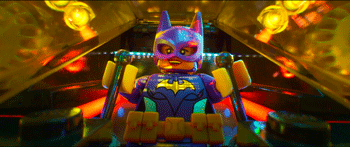 'My dream is for the police force to team up with Batman. Wouldn't that be better?" – Barbara Gordon / Batgirl
'My dream is for the police force to team up with Batman. Wouldn't that be better?" – Barbara Gordon / Batgirl
'Uh… no." – Batman
Batman's disconcerting dilemmas with The Joker and Robin couldn't have cropped up at a worse time, as he would much rather focus his attention on an utterly fascinating woman he's just met: the city's new police commissioner Barbara Gordon, a powerful combination of brains, beauty and confidence.
This newly minted top cop taking over from her father, retired Commissioner Jim Gordon, is a modern woman with modern ideas. A proud graduate of Harvard for Police, Barbara has big plans for cleaning up the streets of Gotham.
Rosario Dawson counts herself as a fan because 'she's such a strong, intelligent, badass character, getting an opportunity to prove herself and enact all the dreams she's had about what she would do with this position. She has good instincts and determination. She loves her city and she works really, really hard."
Barbara doesn't want to exclude or control Batman; she wants to work with him.
Needless to say, this is a radical idea that won't fly with the world's most famous vigilante because, as everyone knows, Batman works alone. Batman's ego-driven mindset can only see Barbara's ideas and law enforcement credentials as subordinate to his own phenomenal skill set. Sure, he wouldn't kick her out of the Batmobile, but she's only welcome to come along for the ride if she understands that he's the one in the driver's seat"which happens to be the ONLY seat because he built it that way. This leads to lots of barbed banter, and some serious one-upmanship.
Says Dawson, 'He can't wrap his head around the fact that she could be inspired by him, influenced by him, and want to work with him, but not want to date him, so the story plays on these old-school stereotypes in a fun way. She really holds her own and he won't give an inch, so they get to know each other and provoke each other in a way that really makes you laugh. Ultimately, what she's saying is, -Can we push past the insecurities and just recognise that my being good at this doesn't take away from your being good at this. It doesn't mean you can't do it on your own. It just means that maybe we can do it better together.' That's her mission."
Returning to the story's central themes, McKay notes, 'This is about working with different people, and the understanding and teamwork that goes along with that. It's Barbara Gordon who carries that attitude; she's the voice of common sense when things get out of hand. We wanted a female character that was strong and aspirational, and I don't believe this character has been explored cinematically in a way that shows how cool she can be."
Fans will likely know, long before LEGO Barbara Gordon herself realises, that she is destined to assume a new secret identify before this latest crime wave is contained. And Batman had better look out, because Batgirl plans to show him she can do anything he can do, including parallel park the Batmobile and rock a cowl with pointy ears. But she'll take hers in purple, thank you.
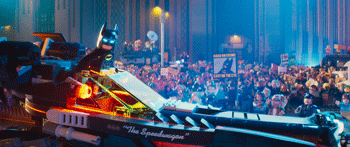 'Sir, it's time for you to stop this unhealthy behavior. You can't spend the rest of your life alone, dressed in black, and staying up all night. – Alfred
'Sir, it's time for you to stop this unhealthy behavior. You can't spend the rest of your life alone, dressed in black, and staying up all night. – Alfred
Alfred has always been a rich character and 'The LEGO Batman Movie" stretches his potential further. Ostensibly an employee, he represents much more to Bruce Wayne, who lost his parents at a tender age before later assuming the persona of Batman. It's Alfred who has made the cavernous Wayne Manor a home. It's Alfred who has been a father figure to him. Now it's Alfred who must help Batman make a vital course correction in his life if he's ever going to learn how to be happy and connect with other people, even if that means taking away his computer privileges and sending him to bed at a reasonable hour.
As Ralph Fiennes observes, 'Alfred has been very tolerant of this adolescent mentality, like a patient uncle or a teacher, tolerating the tantrums and the narcissism while gently nudging Batman to a slightly more grown-up awareness of the world. There's a lot of humor in that relationship, and Alfred is very well-written. I love the wit and the satirical side of it."
It's long been Alfred's custom to wait for Batman to catch up to certain emotional truths on his own. But LEGO Alfred is just a wee bit fed up and feels that when it comes to Batman becoming a better and a happier man, it's now or never. Says Fiennes, 'Batman is a selfinvolved misanthrope who's in his own little world with his workouts and his own needs, and Alfred's goal is to open him up to consider other people before it's too late."
'I love the relationship between Batman and Alfred," McKay offers. 'I love the way Alfred understands what's going on with him and, if he's grappling with a major issue, sometimes gets there before he does. Working with Ralph was a pleasure, and he gave Alfred a personality that not only hit the perfect tone in terms of who he has always been, but also hints at talents and a history that probably Batman doesn't even know about."
Case in point: despite his reserved façade and decades of devoted butlering, LEGO Alfred has some surprises up his molded plastic sleeve, including the fact that he once flew bombers for the Royal Air Force, which comes in handy as the action escalates. Alfred's relationship with Batman also parallels Batman's still-evolving relationship with Robin. As Alfred is a paternal figure for Batman, now Batman must pay it forward by learning to parent Robin. Simultaneously, this underscores the idea that family is where you find it. Says Lin, 'Batman comes to find that people play different roles in his life. Alfred takes the fatherly role, while Robin becomes the son and then Barbara becomes his platonic female friend, so it's this interesting family unit that just comes together for this guy who was so lonely and isolated at the beginning of the story."
Ramping up the fun, 'The LEGO Batman Movie" is additionally populated with LEGO versions of pretty much every bad guy in the Batman pantheon, from The Riddler, The Penguin and Two-Face to Catwoman and Poison Ivy, to lesser-known but no less dangerous denizens of the Rogues Gallery such as Calendar Man, Gentleman Ghost and The Condiment King"with his ketchup and mustard sidearms blazing. Joining forces with them is a motley crew The Joker happily calls out as 'the worst villains in the history of the universe," running the gamut from Dracula and Medusa to more recent personifications of evil that fans will delight in identifying. Also on hand is The Joker's main squeeze, Harley Quinn, voiced by Jenny Slate. A sledge hammer-wielding free spirit, she will do whatever she can to help her sweet Puddin' achieve his glorious dreams of destruction. Additionally, representing the forces of good, members of The Justice League put in an appearance, although their help is not something Batman is counting on. Ellie Kemper voices a surprisingly animate brick by the name of Phyllis, whose job it is to evaluate potential inductees to the infamous Phantom Zone, and Apple's Siri is the voice of -Puter, Batman's companionable command center that runs the Batcave and Wayne Manor.
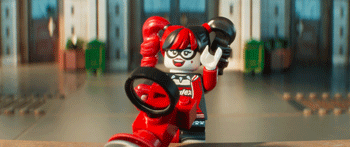 Starring as Mayor McCaskill, decked out in a no-nonsense navy business suit offset by a string of pearls, is Mariah Carey, who says of working in the booth with McKay: 'Having Chris there was like being in the studio recording my music with a really great engineer or producer, to go back and forth. He led me in different directions to see where I could go with it and just to play around with the dialogue and the intention, and presented different options. He allowed me that space, and to have a good time with it. It was an incredible experience for me."
Starring as Mayor McCaskill, decked out in a no-nonsense navy business suit offset by a string of pearls, is Mariah Carey, who says of working in the booth with McKay: 'Having Chris there was like being in the studio recording my music with a really great engineer or producer, to go back and forth. He led me in different directions to see where I could go with it and just to play around with the dialogue and the intention, and presented different options. He allowed me that space, and to have a good time with it. It was an incredible experience for me."
I don't think you could ask for a better cast of people who were brilliant at improvising," McKay states. 'They were all so fast and funny, and so game to play. We put Zach and Will in a room together, and so much great stuff came out of that. There were times they took ideas off the page and turned it into something else and we just let them riff because we were having such a good time. It was the same for Will and Rosario. We paired actors as much as possible. Everyone took ownership of these characters in thoughtful and interesting ways.
'You have to bring everything to an animated movie or there's no beating heart to it," he adds. 'If you have vocal performances that are honest and spontaneous, it helps everything just lift off the screen. Whether they were in the booth with other actors or solo and coming up with their own spin on the material, we would then figure out a way to go back and work that into the animation. It's like sculpture. You start with a big block and begin to understand the shape of it, and then whittle away throughout the process and that's what brings life to these characters."
Production & Animation:
'Initialize master build." – Batman
In the style and technique of the first LEGO movie, 'The LEGO Batman Movie" is constructed of thousands upon thousands of digital bricks created, personalized and assembled in the computer to form the sets, props, Minifigures and other parts of the busy LEGO world these characters inhabit. Once again, the filmmakers turned to preeminent digital animation company Animal Logic, based in Australia, a creative force in the industry whose work includes not only the first LEGO movie but such titles as 'Moulin Rouge!," 'Happy Feet," 'Walking with Dinosaurs" and 'Legend of the Guardians: The Owls of Ga'Hoole."
'We wanted the movie to feel as if people had actually put their hands on these pieces to create this universe and everything in it," says McKay, under whose direction the famed design team at Animal Logic used not only resources created for the original film but added even more assets to their brick library"what A.L. production designer Grant Freckelton refers to as their 'infinite toy box."
Designed to evoke the quality of real LEGO bricks, these universal building blocks were not mass-produced in identical, perfect, shiny batches. Rather, they were modeled and surfaced individually to bear a variety of tiny nicks and smudges, the nuances of patina that a physical LEGO set would be expected to show after years of boisterous play. From there, they were logged according to color, size, and other specs, to be used by the animation teams to put their film together in a visual style that may remind audiences of their own marathon LEGO builds, spread out on a table top or across the living room floor.
The plan, says Dan Lin, was 'to present a world immense in scale, like a Gotham City that you'd never seen before, built out of LEGO bricks. At the same time, it would have a high level of detail that would allow the camera to push in and reveal how intricate it is."
'The main difference between traditional animation and LEGO animation is that you're working within a certain set of rules," adds Freckelton, who also served as production designer on 'The LEGO Movie." 'Everything's built out of LEGO pieces and everything is connected the way real LEGO pieces are connected."
Though sharing its structural DNA with 'The LEGO Movie," the new film has its distinctions, primarily in scale and effects. Whereas the first story was set in the fictional city of Bricksburg, which the filmmakers could contain, this story came with already established largescale environments such as the sprawling urban jungle of Gotham City and the yawning expanse of the Batcave, so it had to be much bigger.
'I used to show Chris potential sets and he'd say, -That's good, but make it three times that size,'" Freckelton recalls.
Animal Logic CG Supervisor Damien Gray estimates that for the Gotham City set alone, what he says is 'one of the largest environments we've ever created here. If you were to build it out of real LEGO bricks it would span about six and a half football fields."
'The LEGO Batman Movie" also employs naturalistic effects. Matthew Ashton, Vice President of Design at The LEGO Group and an executive producer on both films, says, 'In the first movie even the explosions and plumes of smoke and rippling water were brick-built. What we did here is apply different CG effects like real weather, so there'll be rain on the surfaces of the streets, and fog and mist for Batman to appear through, making it more atmospheric."
In addition to McKay and the returning producers, as well as Ashton, Freckelton, and Gray, 'The LEGO Batman Movie" reunited a multitude of artists and production personnel from 'The LEGO Movie," together with new talent throughout the project's span of nearly two-and-ahalf years. Crews worked in Los Angeles and Australia, with input from LEGO designers based in Denmark, with ideas shared either in person or via video conference.
Department heads included animation supervisor Rob Coleman; head of story Trisha Gum; rigging supervisor Josh Murtack; surfacing lead Nerys Lincoln; matte painting lead Dudley Birch; compositing supervisor Alex Fry; modeling supervisor Bradley Sick; effects supervisor Miles Green; and stereoscopic supervisor Fabian Mϋller. David Burrows, Matt Villa and John Venzon served as editors on the film, with camera direction by Behzad-Mansoori-Dara, and lighting direction by Craig Welsh.
McKay likens the assemblage of such a workforce to selecting actors. 'We're really casting a team," he says, 'storyboard artists, animators, layout, editors…bringing all these different people together to build the project. In the way that actors take ownership of their roles, these people take ownership of the scenes and ideas they're working on, so coming to work is fun and everyone is engaged in the filmmaking. It requires a lot of communication and collaboration, and being nimble and open."
In some instances, such as the invention of a new character hair piece, the film team would submit concepts for LEGO review, with such factors as 'clutch power" taken into consideration, meaning the way the bricks actually fasten together. Conversely, Gray elaborates, 'There are all sorts of things in the manufacturing realm we just don't think about in CG, like which colors can and cannot be used in a certain build style. Some of the plastics are tougher than others, so when you're building a model there are certain bricks that should be used for those structural requirements. These are all challenges, but through that we found creative and unique things we wouldn't have otherwise been able to do on our own. Working with LEGO staff was key."
Production was not linear. Although a natural progression exists"from storyboarding and layout meetings through the development of building blocks via modeling, surfacing and rigging, through the addition of lighting, FX and character animation and all the way to the final compositing and editing"progress on 'The LEGO Batman Movie" was fluid and interactive. A LEGO asset might move, for instance, from modeling to rigging to layout, and from there to animation. Surfacing might not get involved till months later. Changes would then cause it to be returned and re-integrated by rigging. New expressions and character movements would require additional surfacing and switching out facial details. 'We iterated on story, and also on the individual assets," Freckelton outlines. 'We might model something, do a rigging brief and discover that it didn't quite work. Or maybe animation wanted to try it a different way, so it would go back to modeling. Often they have ideas of their own or want to add functionality to a vehicle or prop that hadn't previously been conceived. Sometimes they do that by adding their own bricks; other times they ask us to change our assets. What I think is great about the pipeline and the nature of working with modular bricks is that we can easily go from one department to another, and add a piece that can create a new functionality quickly." Two of the film's standout set pieces are Gotham City and the Batcave.
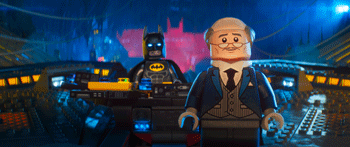 Although fictional, there have been enough vivid depictions of Gotham City to have collectively formed a model, although one that affords a lot of room to move around. Says McKay, 'Our Batman sort of encompasses the entire 78-year history of the property, so we embraced a mix-and-match of various styles. We wanted something that acknowledged those earlier versions while coming up with its own look."
Although fictional, there have been enough vivid depictions of Gotham City to have collectively formed a model, although one that affords a lot of room to move around. Says McKay, 'Our Batman sort of encompasses the entire 78-year history of the property, so we embraced a mix-and-match of various styles. We wanted something that acknowledged those earlier versions while coming up with its own look."
Naturally, it had to harbor ominous corners, backlit streets and the occasional manhole with rising steam, and be comic as well, in its overstated silhouettes and saturated colors.
As vast as it is detailed, the movie's Batcave has many uses: it's the docking port and warehouse for Batman's fleet of vehicles; a repository of his costumes and disguises; a multilevel museum of artifacts from a lifetime of crime-fighting exploits; and his computer nerve center. 'The Batcave was meant to be ludicrous," Freckelton concedes. 'The benefit of tackling things in a humorous way is that you can ask yourself what a person would build if they had literally billions of dollars to spend and an ego to match that amount of money. Chris imagined it infinitely deep and tall and full of technology. Built end to end, I think, it would be a half mile. We have a spinning carousel system where every vehicle he's ever used is on display, and we put in as many bat shapes as possible, which is cool because LEGO bricks are naturally angular and you can interpret a bat shape pretty quickly out of various wedges.
'Everything is overly designed and engineered, very industrial," Freckelton adds. 'Batman goes from point A to point B not by walking but by hopping onto these crazy robotic moving platforms."
Additional sets include Wayne Manor, patterned after American mansions of the 1920s and 30s and reminiscent of Citizen Kane's palatial Xanadu, with hints of New York's Boldt Castle. The multi-level Arkham Asylum, built around a central watchtower, was a hybrid of a high-security prison and a hospital, which the production designer calls a blend of 'sci-fi prison below and old-timey prison up above." The Phantom Zone, the ultimate place of punishment for the criminal world's worst of the worst, was rendered in super-bright, white bricks, because it was determined that this would most infuriate those who prefer living in the shadows.
A great deal of the animation artistry focused on the characters, imbuing them with the attitudes, feelings and personalities born of the actors' performances. Postures were limited, but within those parameters much was achieved. Lighting and timing, combined with a range of minutely and rapidly graduated facial features in the form of decal-like overlays, helped to bring expression to their eyes and mouths"registering everything from joy, hope and affection to shock, fear, humor and sarcasm.
Animation supervisor Rob Coleman says, 'It's interesting, as human beings, that we can make anything come to life if we have an imagination, and I think that for generations of kids, and fans young and old, it's almost as if you cannot help yourself when you pick up a LEGO character and start moving it along a table or start talking with it. That's what the animation team has tried to tap into: that joy of play."
By staging and shooting the film in every way like a big, dramatic, live-action adventure, McKay further lent the characters and the story a sense of gravity and emotion, even while taking pot-shots at every tenet of such films and never denying for an instant that the leads are little plastic figures inhabiting a world composed of little plastic bricks.
That approach extended to the film's score, composed by Lorne Balfe, who comments, 'We could have gone down the route of parodies but when you do that, you lose the joke, so we took it seriously. Chris is an encyclopedic reference for action hero films, but to him the important thing is the heart of the story, so I didn't think of it as a comic, but as real, live action. The opening is bombastic, those first 10 minutes especially, and then there's the confrontation with The Joker, which really breaks your heart. For a tender scene with Robin, later, we brought in a fantastic choir."
Bruce Wayne's theme, Balfe adds, 'is purely classical and true to his origins because whenever you see Batman you feel the legacy of Batman."
'We make light of his situation," grants Will Arnett, 'but no matter how goofy this movie is and how much we hope people find it funny and have a good time watching it, there's a real story here about a man who has experienced real loss. I think people will still connect with that as long as we stay true to that part of him."
Batman has been part of the culture for a long time, and McKay feels, 'he can handle a range of interpretations while still being the character we know and love. We wanted to dive into some of the Batman mythology and see how much fun we could have with the animation and the characters, and Batman's big personality.
'Because it's a LEGO movie, there are built-in themes about creativity and play, teamwork and sharing," McKay concludes. 'That's inherent in the property and will always be a part of what we do. And because it's a Batman movie, there are underlying ideas about family and connection. But we also wanted to say something about the nature of happiness. Can a guy who's based his image on being that dark silhouette on a rooftop, bearing all the responsibility of keeping Gotham City safe, make happiness a choice? I think it's interesting to recognize that there will always be obstacles and conflicts in life, good days and not-so-good days, but that maybe choosing happiness as a philosophy isn't a bad way to go.
The Lego Batman Movie
Release Date: March 30th, 2017
MORE


